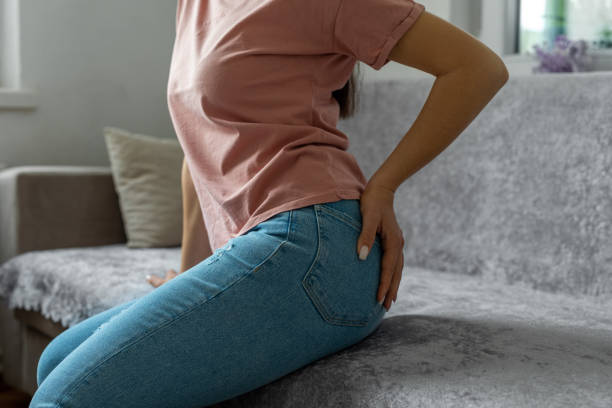Menstruation is a natural and essential part of a woman’s reproductive cycle, but it often comes with various discomforts, including cramps. While abdominal cramps are commonly associated with periods, many women also experience cramps in their buttocks during menstruation. These cramps can be not only physically uncomfortable but also emotionally distressing.
In this comprehensive guide, we will explore the causes of buttock cramps during periods and provide practical tips and strategies to alleviate and prevent them.
Understanding Buttock Cramps During Menstruation
- Muscle Contractions and Menstruation: Menstrual cramps, scientifically known as dysmenorrhea, occur due to the contractions of the uterus as it sheds its lining. These contractions are essential for expelling menstrual blood. However, the effects of these contractions can extend beyond the uterine area, causing discomfort in surrounding muscles, including those in the buttocks.
- Referenced Pain: Buttock cramps during menstruation can also be an example of referred pain, where the sensation is felt in an area distant from the actual source. The nerves that transmit pain signals from the pelvic region may overlap with those from the buttocks, leading to the perception of cramps in the buttock muscles.
- Hormonal Changes: Hormones play a significant role in the menstrual cycle, and their fluctuations can contribute to muscle cramps. Prostaglandins, in particular, are hormone-like substances that are released during menstruation, triggering uterine contractions and potentially affecting other muscles, including those in the buttocks.
Alleviating Buttock Cramps During Menstruation
Now that we have delved into the potential causes of buttock cramps during menstruation, it’s crucial to explore comprehensive strategies to effectively alleviate and prevent this discomfort. Adopting a holistic approach to menstrual health involves incorporating various lifestyle modifications and evidence-based practices that can contribute to overall well-being.
- Maintain a Healthy Lifestyle: To address buttock cramps during menstruation, cultivating a healthy lifestyle is fundamental. This encompasses two key aspects:
- Regular Exercise: Engaging in consistent physical activity plays a pivotal role in promoting overall muscle health and mitigating the severity of cramps. Activities such as walking, swimming, or yoga are particularly beneficial. Incorporating these exercises into your routine can enhance blood circulation, alleviate muscle tension, and contribute to a healthier menstrual experience.
- Balanced Diet: Ensuring a diet rich in essential nutrients, including calcium, magnesium, and potassium, is essential for regulating muscle function and reducing cramping. Incorporate foods like leafy greens, dairy products, nuts, and seeds into your diet to support overall health, including muscular well-being during menstruation.
- Stay Hydrated: Dehydration can exacerbate muscle cramps, making adequate hydration a crucial element in managing buttock cramps during your menstrual cycle. Maintaining optimal fluid intake supports overall muscle health and can help alleviate the intensity of cramping episodes.
- Heat Therapy: Heat therapy is a proven method for relieving muscle tension and cramps. Incorporating the following practices can be particularly effective:
- Warm Baths: Soaking in a warm bath not only provides relaxation but also helps ease tense muscles, providing relief from buttock cramps. Enhance the therapeutic effect by adding Epsom salts to the bathwater, known for their muscle-soothing properties.
- Hot Compresses: Applying a hot compress to the buttock area can offer localized relief. Whether using a heating pad or a hot water bottle, the warmth can help relax muscles and alleviate cramping discomfort.
- Over-the-Counter Pain Relievers: Non-prescription pain relievers, such as ibuprofen or naproxen, can be effective in reducing inflammation and alleviating menstrual cramps, including those in the buttocks. However, it’s imperative to consult with a healthcare professional before incorporating these medications regularly to ensure proper usage and minimize potential side effects.
- Prescription Medications: In cases of severe menstrual cramps, healthcare providers may prescribe stronger medications to address pain and muscle spasms. It is essential to adhere to the prescribed dosage and seek professional advice if needed, ensuring the safety and efficacy of the prescribed medications.
- Hygiene and Comfort: Paying attention to hygiene and comfort during menstruation is vital for minimizing discomfort, including buttock cramps. Consider the following:
- Choose Comfortable Clothing: Opt for loose-fitting, comfortable clothing during your period to minimize constriction and reduce overall discomfort, including buttock cramps.
- Use Quality Menstrual Products: Selecting high-quality menstrual products that suit your needs can prevent leakage and provide comfort, allowing you to move without additional stress on your muscles.
- Stretching and Exercise: Incorporating specific exercises and stretches targeting the pelvic and buttock muscles can significantly contribute to reducing cramping. Consider the following:
- Gentle Stretches: Integrate gentle stretches into your routine, focusing on the pelvic and buttock muscles. Yoga poses such as Child’s Pose or Pigeon Pose can be particularly beneficial in alleviating tension.
- Pelvic Floor Exercises: Strengthening pelvic floor muscles through exercises like Kegels can enhance overall pelvic health and contribute to reducing cramping during menstruation.
- Acupuncture and Massage: Exploring alternative therapies such as acupuncture and professional massage can provide additional relief from buttock cramps:
- Acupuncture: Some individuals find relief from menstrual cramps, including buttock cramps, through acupuncture. Consulting with a qualified practitioner can help determine if this alternative therapy is suitable for you.
- Massage Therapy: Professional massage targeting the buttock and pelvic areas can effectively relax tense muscles, improve blood circulation, and alleviate cramping discomfort during menstruation.
By incorporating these holistic strategies into your routine, you can create a proactive approach to managing and alleviating buttock cramps during menstruation. Remember, individual responses may vary, so it’s essential to explore and tailor these practices to suit your unique needs. Seeking guidance from healthcare professionals can further enhance your menstrual well-being.
Preventing Buttock Cramps During Menstruation
- Regular Exercise Routine: Establish a consistent exercise routine that includes activities focused on overall muscle health, promoting better blood circulation, and reducing the severity of cramps.
- Dietary Modifications:
- Anti-Inflammatory Foods: Include foods rich in omega-3 fatty acids, such as fatty fish and flaxseeds, to help reduce inflammation and alleviate cramps.
- Limit Caffeine and Alcohol: Both caffeine and alcohol can contribute to dehydration and may exacerbate muscle cramps. Limit their consumption, especially during your menstrual cycle.
- Hydration Habits: Develop healthy hydration habits, ensuring you drink an adequate amount of water throughout the day to prevent dehydration-related cramping.
- Stress Management: Practice stress-reducing techniques, such as meditation, deep breathing, or mindfulness, to minimize the impact of stress on muscle tension and cramps.
- Supplements: Consider supplements like magnesium, which plays a crucial role in muscle function and may help alleviate menstrual cramps. Consult with a healthcare professional before adding supplements to your routine.
- Regular Health Check-ups: Schedule regular check-ups with your healthcare provider to monitor and address any underlying health conditions that may contribute to menstrual cramps.
Conclusion
Menstrual cramps, including those in the buttocks, are a common experience for many women. While they can be uncomfortable, adopting a holistic approach to menstrual health can significantly alleviate and prevent buttock cramps. By incorporating lifestyle modifications, effective pain management strategies, and seeking professional guidance when needed, women can navigate their menstrual cycles with greater comfort and well-being. It’s essential to listen to your body, prioritize self-care, and consult with healthcare professionals for personalized advice tailored to your unique needs.





